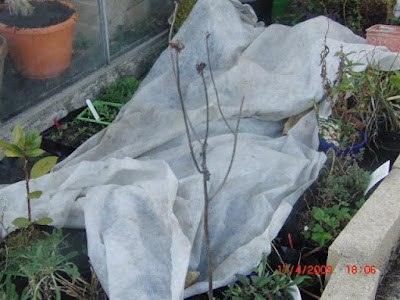Roses are red
Violets are blue
Sugar is sweet
And so are you
I planted a little clump of sweet violets (viola odorata) a few years ago, and at last it seems to have taken off, and is flowering and spreading well. This morning was fine and sunny, perfect for enjoying the sweet scent of this low growing native plant. There are lots of dog violets growing wild around here, but as they are unscented (viola riviniana) they are, at least to me, much less attractive to grow. The plant grows low to the ground, throwing out runners, and making a dense weed suppressing mat (eventually), if it's happy. The flowers, although tiny are beautifully scented, and are of course, the violets beloved of elderly aunts and have been used extensively in the production of perfumes and toiletries as far back as Ancient Greece.

There is a myth that you can only smell violets once but the fragrance is strangely short-lived. Apparently one of the chemicals, ionine, which makes up the violet’s scent, has the ability to deaden the smell receptors that detect it (according to Flora Britannica by Richard Mabey). I used to live in Torquay in Devon where the Lownds Pateman company produced the famous Devon Violets perfume so beloved of the above mentioned aunts, and I well remember visiting their offices and being almost overcome by the smell of the perfume, only to be informed by the owner that he couldn't smell anything and nor could anyone who worked there either!
Violets are steeped in folklore and myth, the Victorians associated them with fidelity and love, and they were traditionally placed on the graves of children. They feature in many lovely poems, including this one by D H Lawrence, - it's a bit impenetrable written down especially if you're not from Yorkshire,(or is that Nottinghamshire?) and much better spoken as here by Kenneth Branagh in the film "Coming Through"
Violets
Sister, tha knows while we was on the planks
Aside o' th' grave, while th' coffin wor lyin' yet
On th' yaller clay, an' th' white flowers top of it
Tryin' to keep off'n him a bit o' th' wet,
An' parson makin' haste, an' a' the black
Huddlin' close together a cause o' th' rain,
Did t''appen ter notice a bit of a lass away back
By a head-stun, sobbin' an' sobbin' again!
How should I be lookin' round
An' me standin' on the plank
Beside the open ground,
Where our Ted 'ud soon be sank ?
Yi, an' 'im that young,
Snapped sudden out of all
His wickedness, among
Pals worse n'r ony name as you could call.
Let be that; there's some o' th' bad as we
Like better nor all your good, an' 'e was one.
--An' cos I liked him best, yi, bett'r nor thee,
I canna bide to think where he is gone.
Ah know tha liked 'im bett'r nor me. But let
Me tell thee about this lass. When you had gone
Ah stopped behind on t' pad i' th' drippin' wet
An' watched what'er 'ad on.
Tha should ha' seed her slive up when we'd gone,
Tha should ha' seed her kneel an' look in
At th' sloppy wet grave--an' 'er little neck shone
That white, an''er shook that much, I'd like to begin
Scraightin' my-sen as well. 'Er undid her black
Jacket at th' bosom, an' took from out of it
Over a double 'andful of violets, all in a pack
Ravelled blue and white--warm, for a bit
O' th' smell come waftin' to me. 'Er put 'er face
Right intil 'em and scraighted out again,
Then after a bit 'er dropped 'em down that place,
An' I come away, because o' the teemin' rain.
D.H. Lawrence
Both the flowers and leaves are edible, and can be used in salads, and the flowers can be candied and used as edible cake decorations.


























